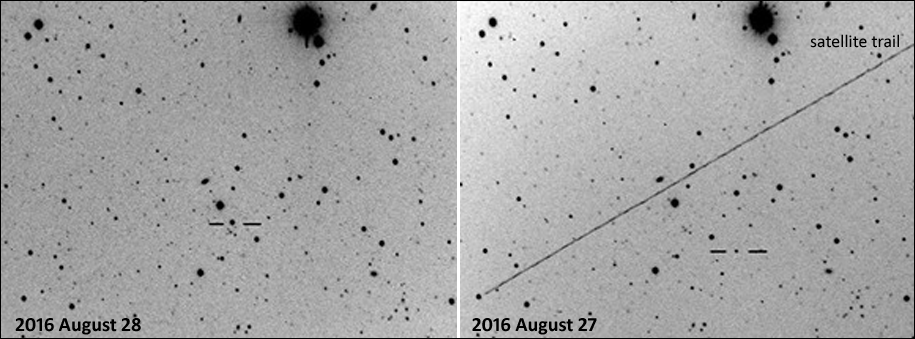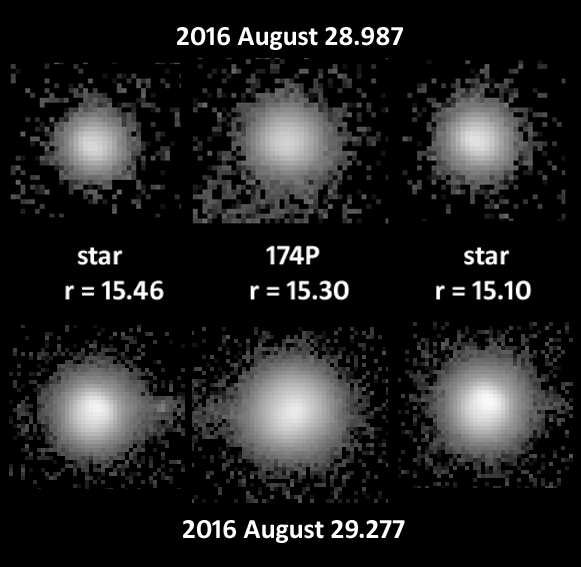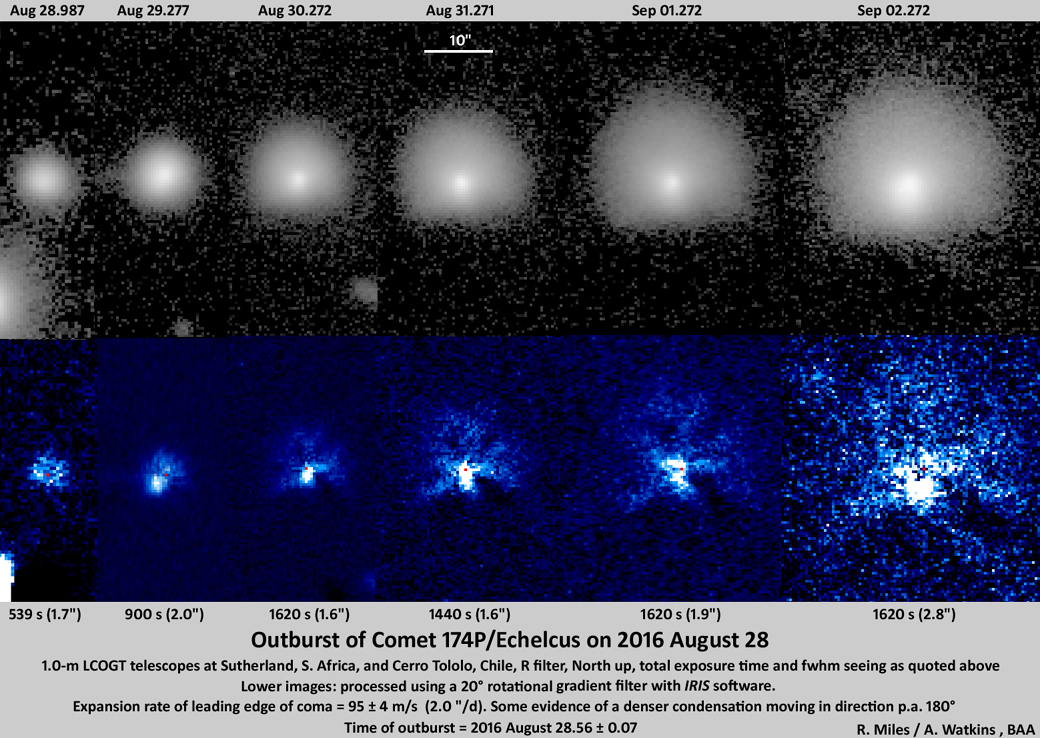-
Faulkes Telescope Project Privacy Policy
Very rare outburst of Comet 174P/Echeclus
First discovered as an asteroid by Spacewatch in 2000, it was named (60558) Echeclus and it remained as an inconspicuous object for the next 5 years, until that is it burst into life, ejecting a dust coma into space and transforming itself into a comet in December 2005. Now known as Comet 174P/Echeclus, it belongs to the class of objects known as Centaurs that are situated quite far from the Sun sandwiched between the orbits of Jupiter and Neptune.
It turns out that a large fraction of distant periodic comets have a tendency to outburst in this way. Indeed Halley’s Comet exhibited such an outburst in 1991. The reason is to do with colder temperatures far from the Sun and the properties of hydrocarbons (if present), especially methane, which can readily exist as a liquid provided a crust has formed on the nucleus of the comet so that a finite pressure can be retained below its surface. If liquid methane collects in a subsurface reservoir, gases such as carbon monoxide, nitrogen and even oxygen can dissolve in it, liberating a considerable amount of heat in the process. An outburst occurs when the amount of dissolved gas is large and the overlying crust is weakened by the heat of the Sun such that it gives way releasing the pressure above the liquid reservoir. What happens next is entirely analogous to quickly removing the cork from a bottle of champagne. A fountain of gas-borne liquid projects out into space taking with it lots of dust and debris, which from the Earth we see as a rapidly expanding coma.
Since 2005, Echeclus had only clearly outburst once in 2011. It takes about 35 years to orbit the Sun and only recently was it closest at a perihelion distance of 5.8 AU in April 2015. Amateur astronomers keep a close watch on various comets with 174P being no exception.
It was during a routine monitoring exercise on August 28 that Paul Camilleri observing from Blue Mountains Observatory, Leura, NSW, Australia, using his 0.30-m telescope, noticed that the comet had appeared to have brightened by a factor of 10 compared to images he had taken of it the previous night. Here are Paul’s discovery images:

As can be seen, the comet looked entirely like a magnitude 15 star when discovered, except that, unlike a star, it was moving. Paul emailed the writer directly, and as part of the Faulkes Telescope Projectactivities, observing time was requested there and then.  Within a few hours, images taken by a 1.0-m scope at Sutherland, S. Africa confirmed the outburst. Further images were obtained with a 1.0-m f/8 Ritchey-Chretien instrument at Cerro Tololo, Chile. Looking at the comet alongside stars of similar brightness revealed it starting to expand:
Within a few hours, images taken by a 1.0-m scope at Sutherland, S. Africa confirmed the outburst. Further images were obtained with a 1.0-m f/8 Ritchey-Chretien instrument at Cerro Tololo, Chile. Looking at the comet alongside stars of similar brightness revealed it starting to expand:
Over the next few days, images were secured every night from Chile thanks to scheduling by BAA member, Eric Watkins, and the results are shown in the following montage:
In later images, a somewhat hemispherical cloud of dust is clearly visible with the nucleus embedded within. Tracking back to the very first image, the nucleus appears to be partially obscured by the bright coma.
Outbursts are very sudden events akin to a geyser or volcano erupting. Indeed, the source of an outburst can be thought of as a cryovolcano where instead of molten rock being thrown out, molten cometary ices are ejected at temperatures as low as -170°C to -220°C. Some slow-moving debris can be seen emanating from below the nucleus in the specially processed images shown in blue-white false colour above. Observers will keep watch on these features over the coming weeks. Their slow motion is probably a consequence of their moving towards us as they spread out into space.

No-one has ever followed the development of an outburst from the quiescent state – a bit like waiting for a volcano to erupt – but Paul Camilleri was very close to having done just that. By back-tracking the motion of the expanding shell of material, the start of the outburst can be estimated and it turn’s out that Paul’s images were made just 1-3 hours after Comet 174P’s outburst. That’s really close given that this object last did something similar back in 2011.
Richard Miles
British Astronomical Association
2016 September 3
Posted in News
